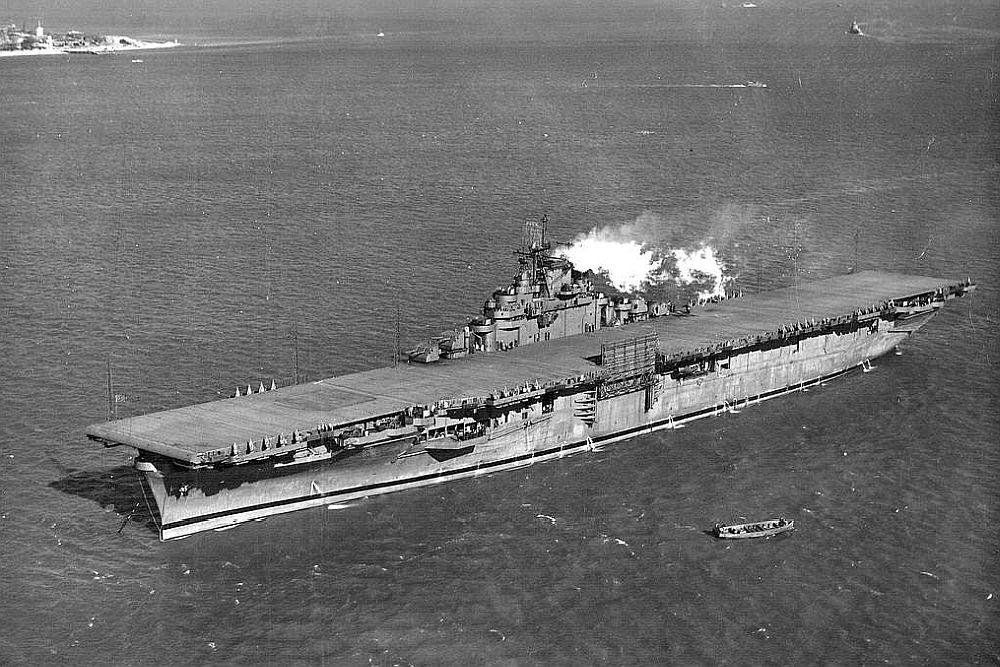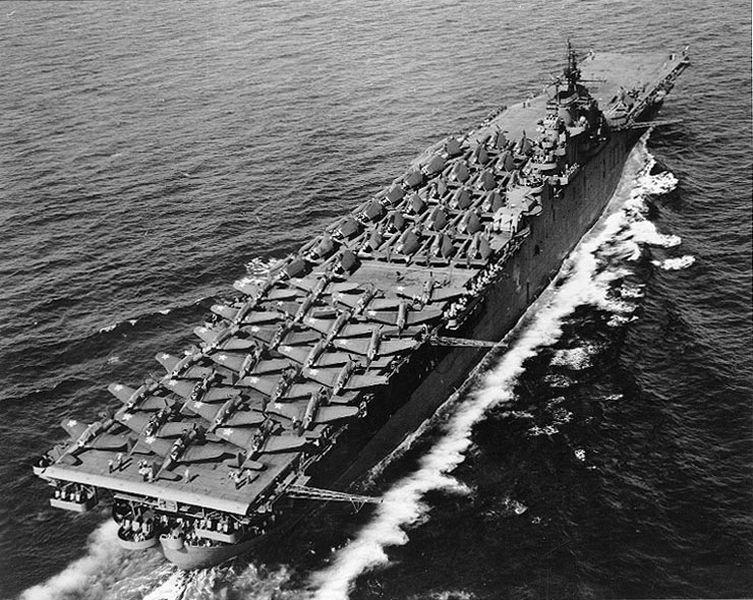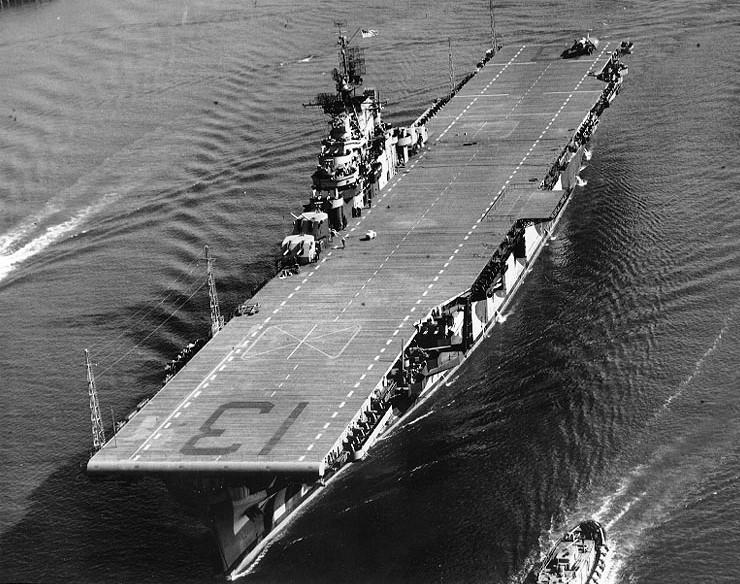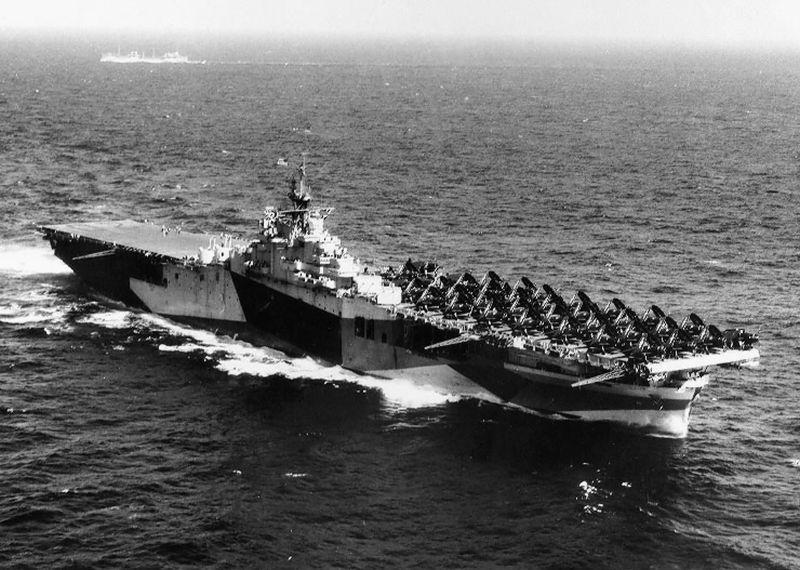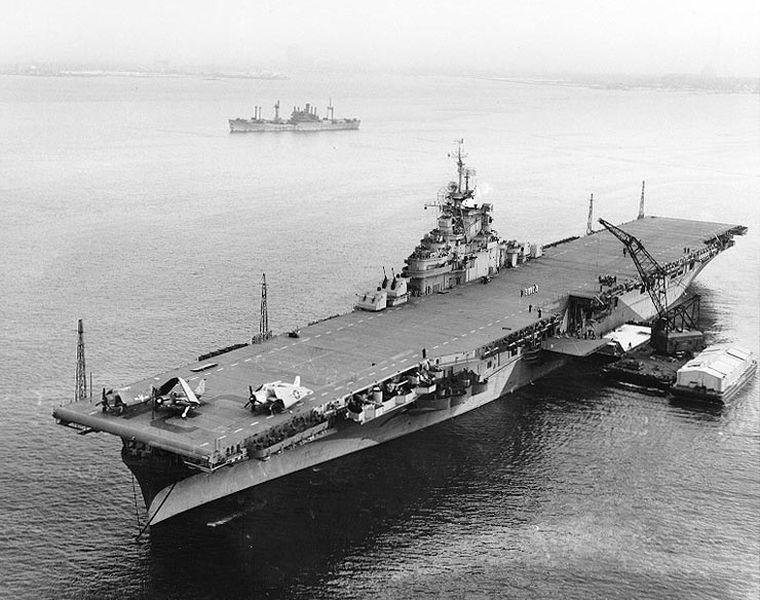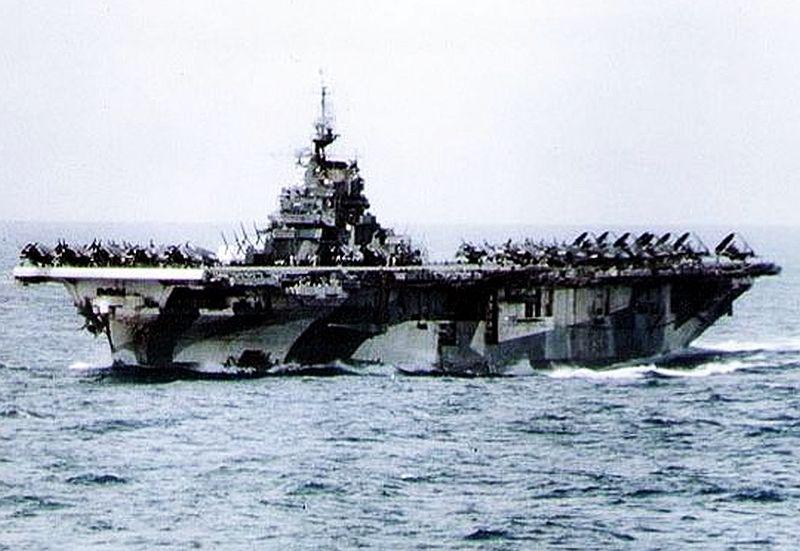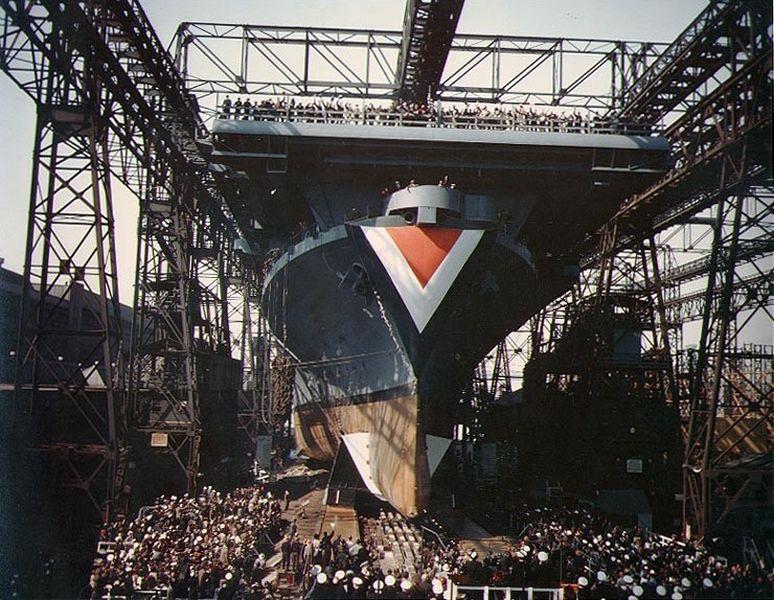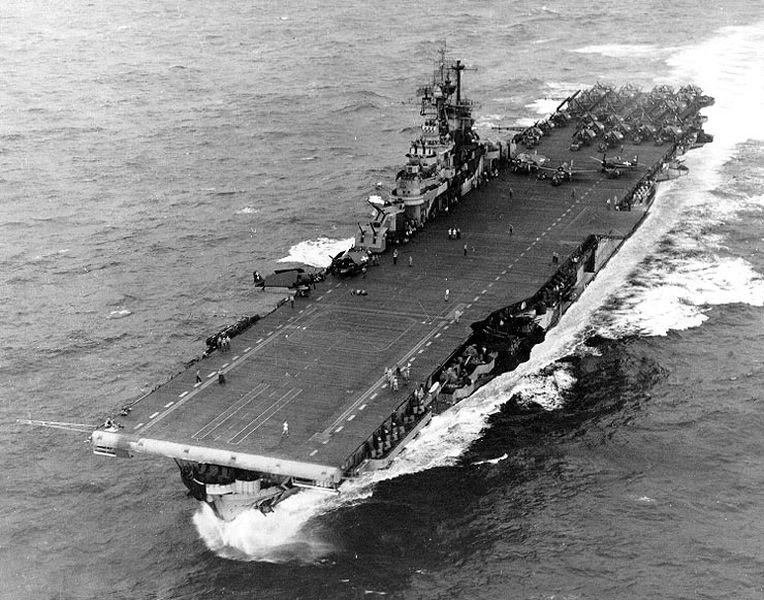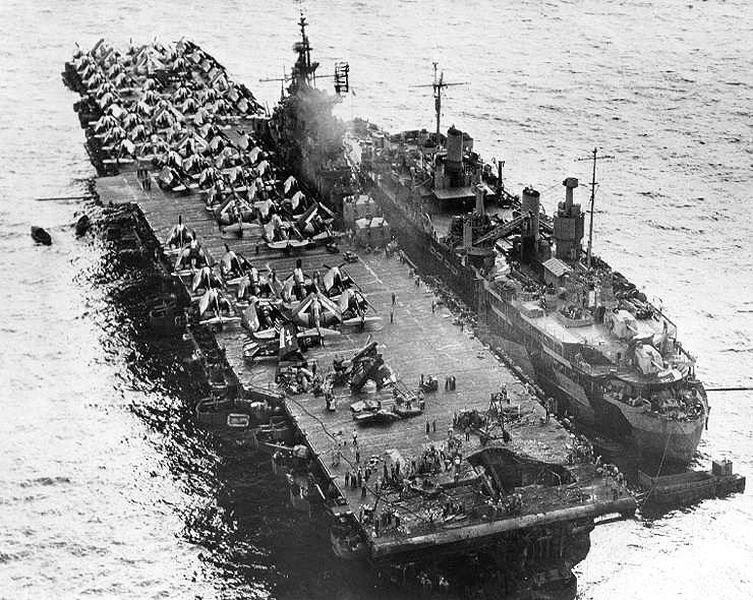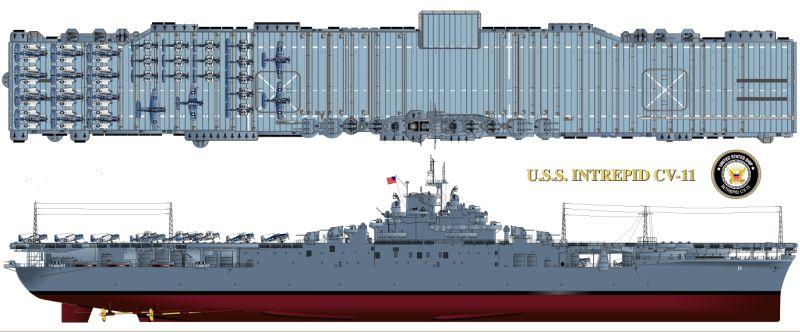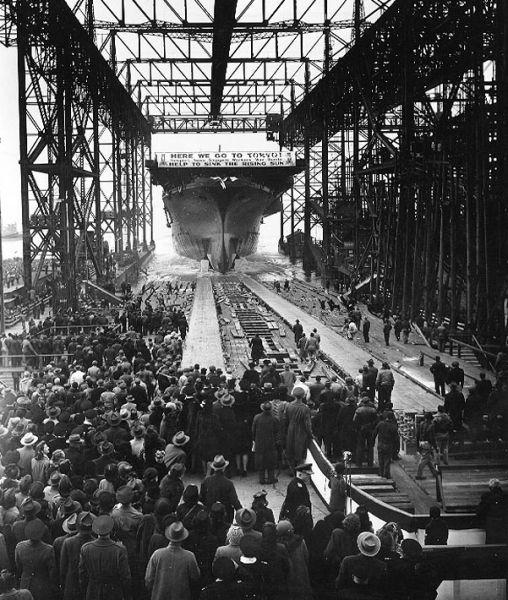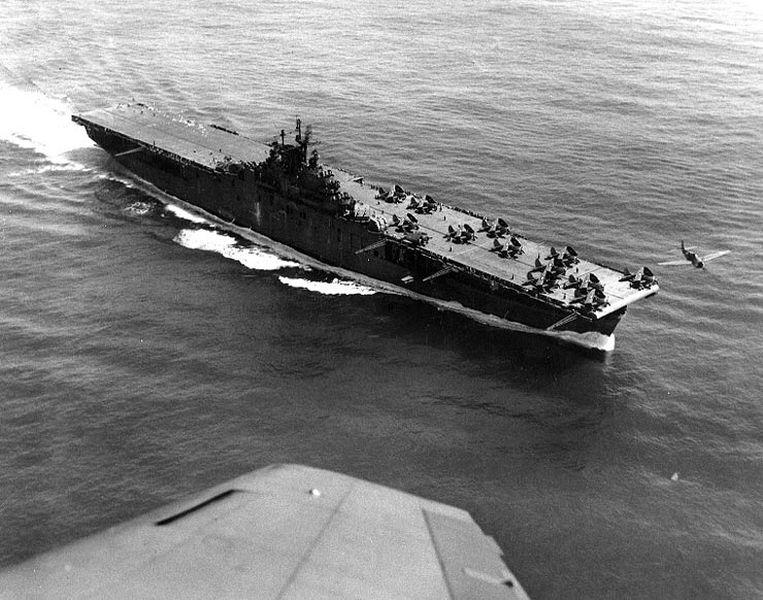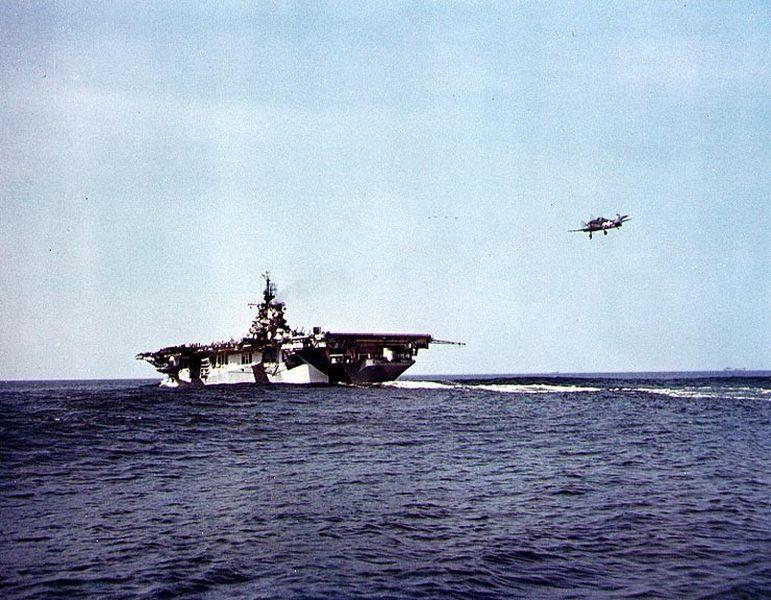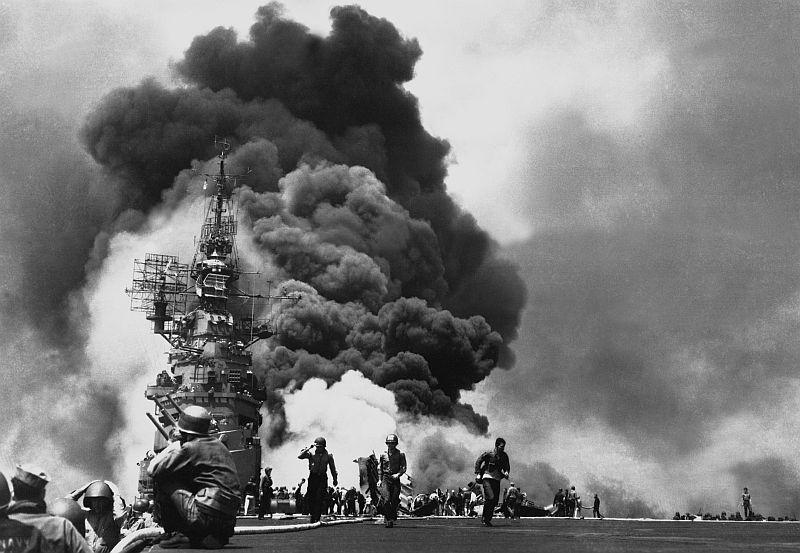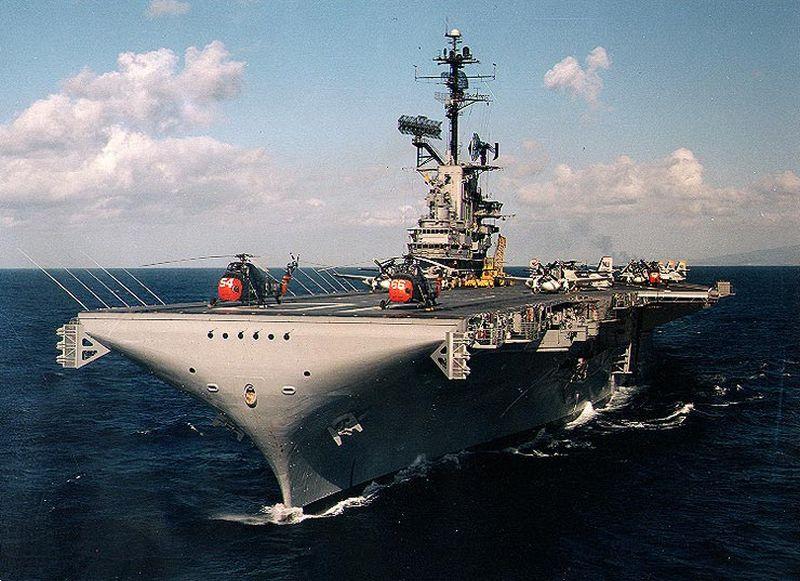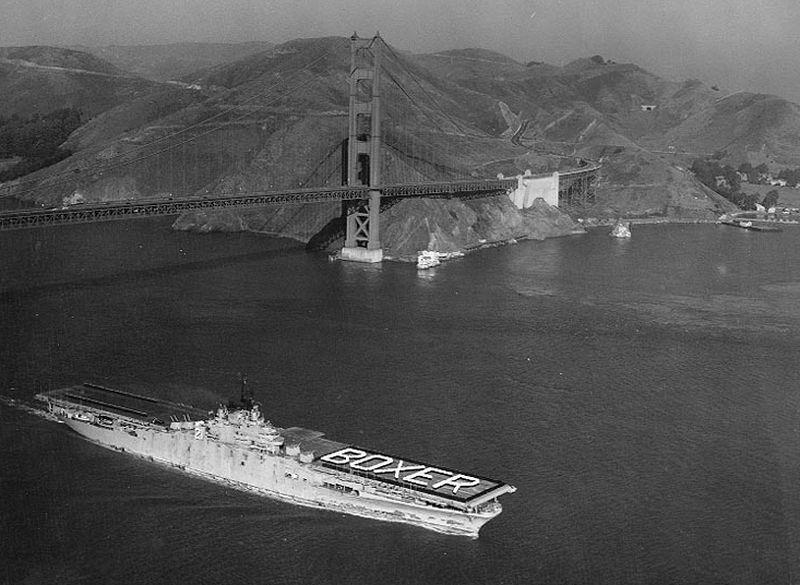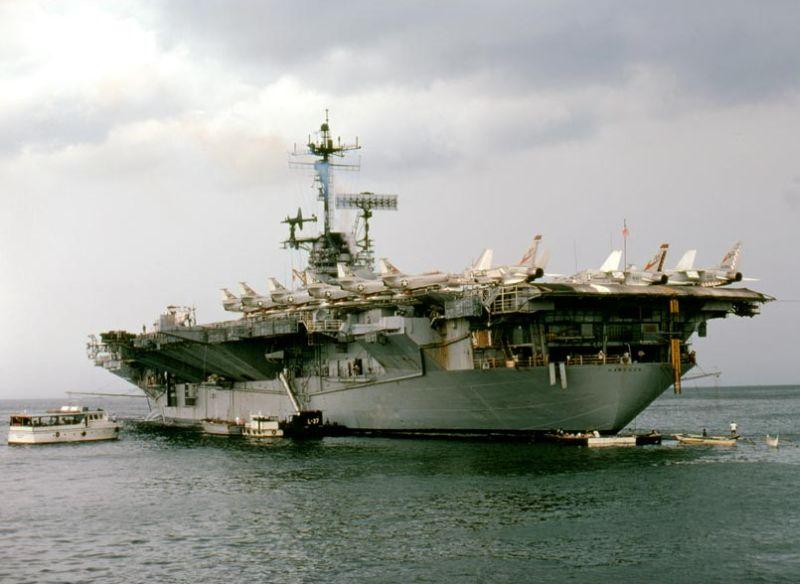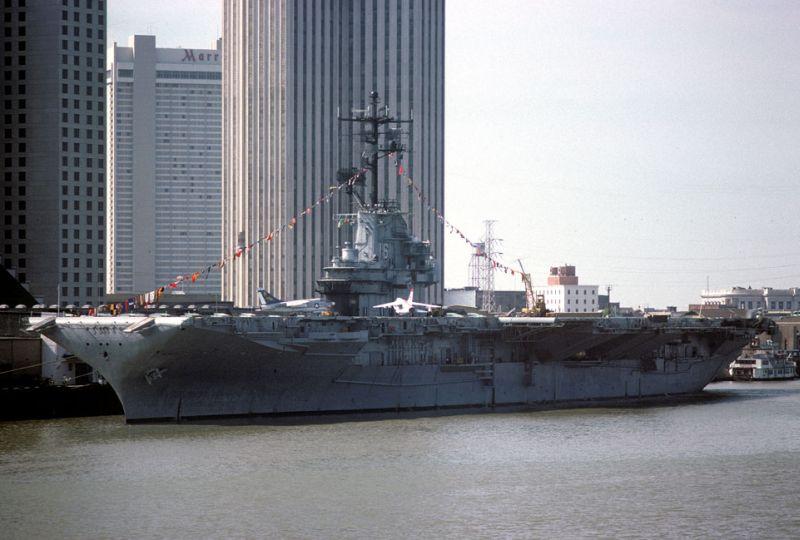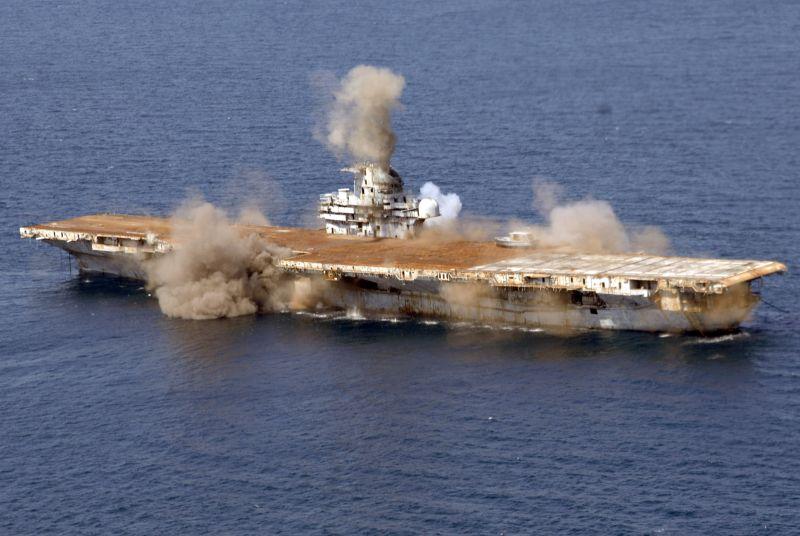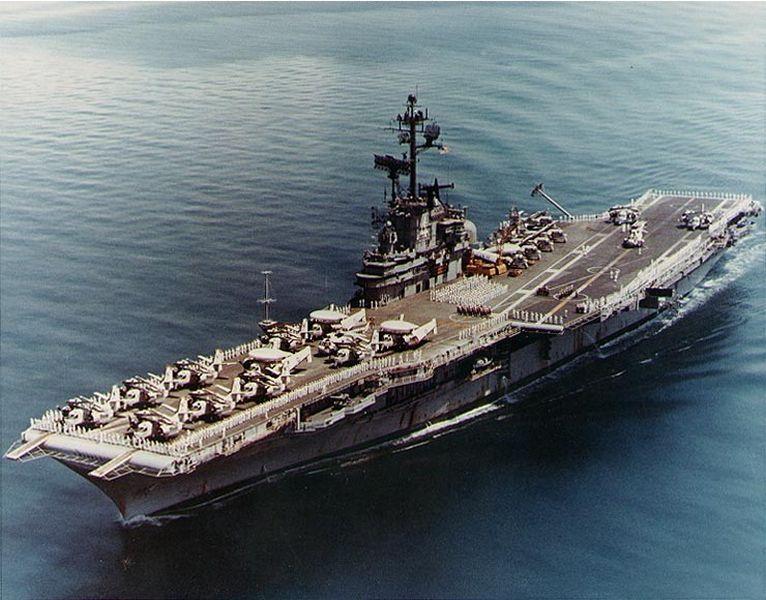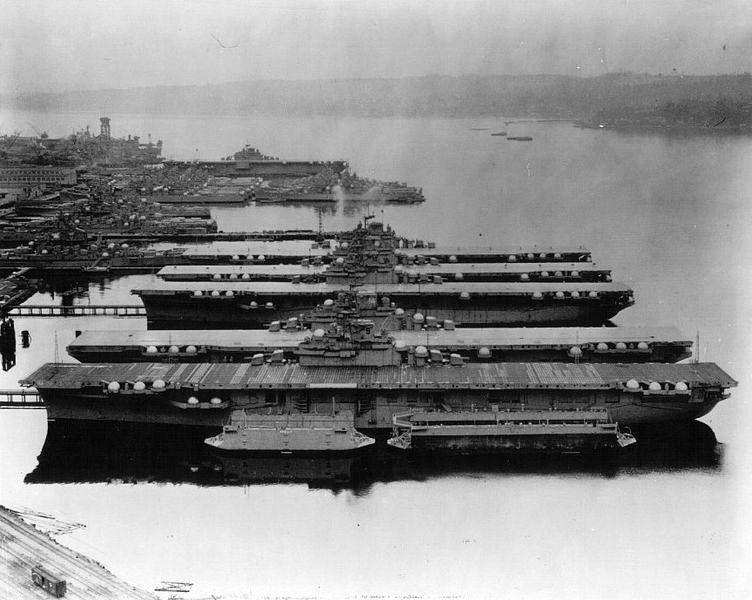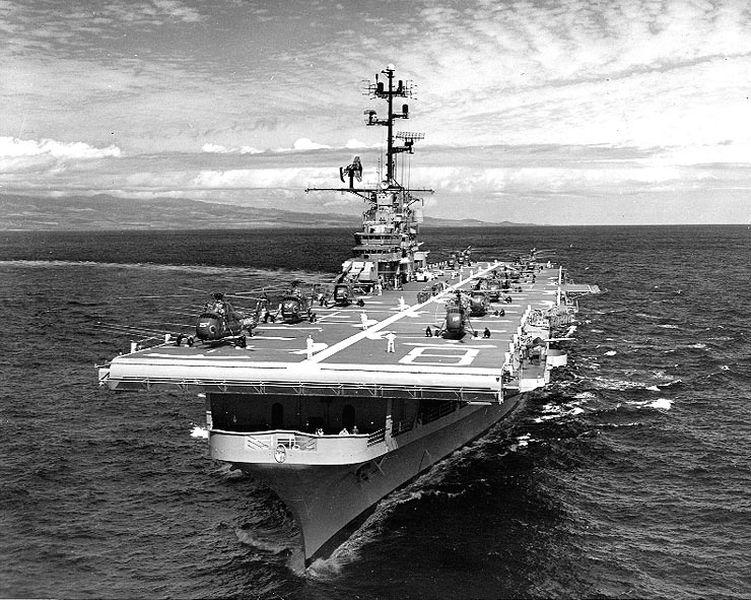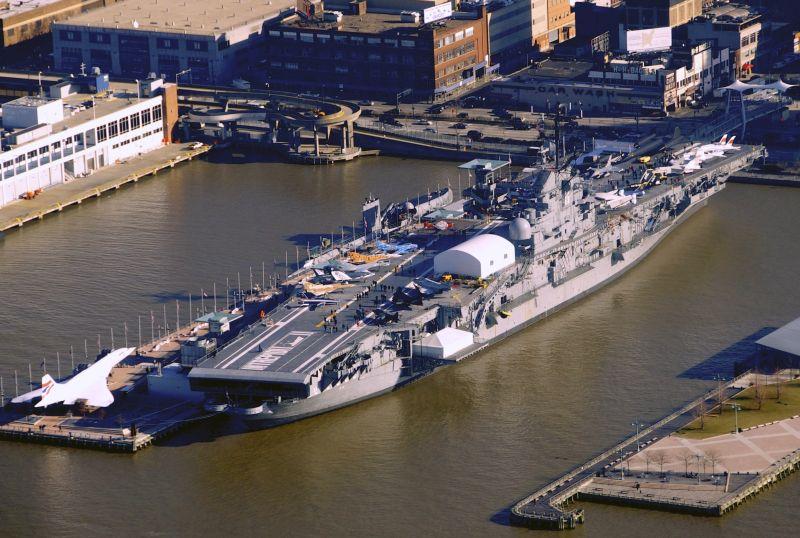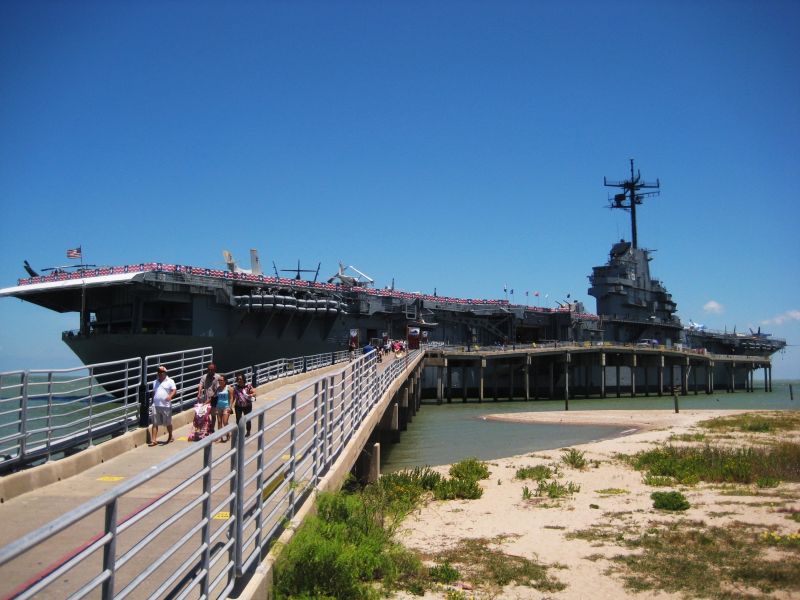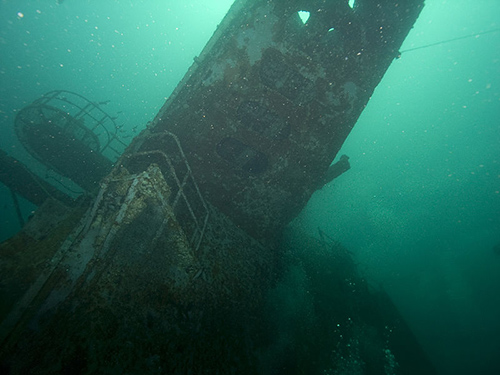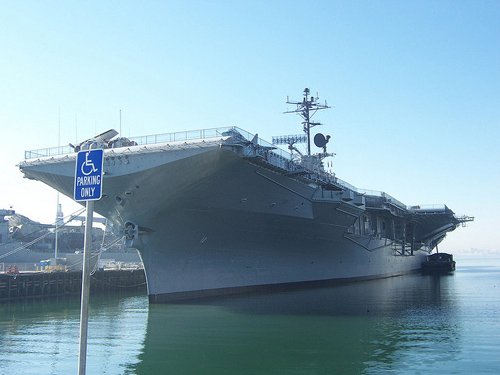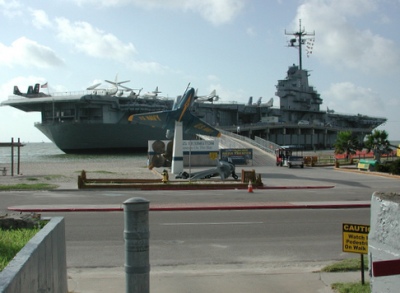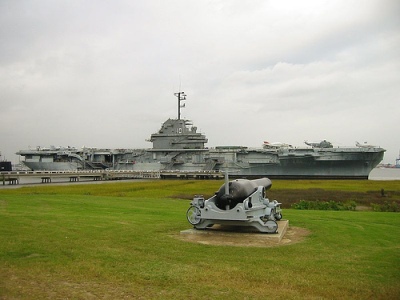Introduction
Engineers started the design of the Essex-class aircraft carriers of the US Navy just prior to the start of World War 2 as soon as all previous limitations of the naval sea treaties had been rescinded. Shortly after the USA entered the war in 1941, the very first carrier of this class, USS Essex, entered service. A total of 24 have been built, 18 of which during World War 2. Through their innovative design and size, they soon played a pivotal role in the war, specifically in the Pacific, and paved the way for replacing the battleship as the backbone of any global naval force. Through successive modernisation programs, the Essex-class continued to play a key role in the US Navy throughout the 1950s and the early 1960s, until replaced by the US Navy's super carriers.
Definitielijst
- battleship
- Heavily armoured warship with very heavy artillery.
History
The Essex-class aircraft carriers were the successors to both the Yorktown class, which consisted of USS Yorktown (CV-5), USS Enterprise and USS Hornet (CV-8), and the light aircraft carrier USS Wasp (CV-7). These aircraft carriers were designed by the Bureau of Ships (BuShips), the department within the US Navy responsible for the design and development of warships within the terms of both the Washington 1922 and London 1930 Treaties, which were extended in 1936. Under these treaties, the world's largest naval powers (Great Britain, the United States, Japan, France and Italy) agreed that each participating country could only have a certain number of battleships and aircraft carriers, further capped by a maximum tonnage. For the United States, this implied that the US Navy was permitted to put aircraft carriers into service with a combined displacement of 135,000 tons, among others. In 1937, Japan and Italy announced that they would no longer honour the fleet treaties. As a result, soon thereafter, the other participating countries also ignored the limitations stipulated by the agreements.
A direct consequence of the treaty having fallen apart, the now essentially unlimited tonnage enabled BuShips to design an improved version of the Yorktown class that would be considerably larger. This improved design also applied to the one-off Wasp, which was in fact a downsized version of the Yorktown. In 1938, the engineers came up with a design for an enlarged Yorktown of more than 27,000 tons, sufficient to meet all US Navy requirements. These requirements included that the aircraft carriers should be able to operate with 90 aircraft, which could also be launched faster than before. The ships should also have as standard up to 25 percent of all spare parts required for the aircraft on board. Enhanced anti-aircraft defence capacity and better armour protection should enable the new class of aircraft carriers to survive in combat situations. Furthermore, the ships had to be able to last a long time and a structure to allow for future major modernisations.
BuShips managed to meet all these wishes and when USS Essex was commissioned on December 31, 1942, the US Navy had a carrier that fully met its requirements. USS Essex could carry 100 fighter aircraft, which could be quickly moved from the hangar desk to the flight deck thanks to an outboard elevator. Previously this was done by inboard elevators, the main disadvantage of which was that they created a large hole in the flight deck when standing or moving at hangar deck level. Until then, only USS Wasp (CV-7) had an outboard elevator, and this was found to be very useful. Furthermore, the aircraft carriers proved to be able to survive very well, even during the fiercest naval battles. This would become apparent when both USS Franklin and USS Bunker Hill were able to withstand the heaviest Japanese kamikaze and bomb attacks and return to a safe harbour under their own power. After the war, the Essex-class aircraft carriers were extensively modified several times, demonstrating that the carriers were also very suitable for this. Moreover, most of the Essex class carriers had an extensive service of more than 30 years..
Definitielijst
- kamikaze
- “Divine Wind”. A kamikaze pilot would fly himself, his airplane and bomb(s) literally into an enemy target, preferably a US ships. This was a noble cause, considered a most honourable death for the emperor. Several thousands of kamikaze pilots died this way.
Class overview 1
| Ship | Hull class. nr | Shipyard* | Keel laid | Launched | Commissioned |
| USS Essex | CV-9 | NNS&DD | April 28, 1941 | July 31, 1942 | December 3, 1942 |
| USS Yorktown | CV-10 | NNS&DD | December 1, 1941 | January 21, 1943 | April 15, 1943 |
| USS Intrepid | CV-11 | NNS&DD | December 1 de, 1941 | April 26, 1943 | August 16, 1943 |
| USS Hornet | CV-12 | NNS&DD | August 3, 1942 | August 30, 1943 | November 29, 1943 |
| USS Franklin | CV-13 | NNS&DD | December 7, 1942 | October 14, 1943 | January 31, 1944 |
| USS Ticonderoga | CV-14 | NNS&DD | February 1, 1943 | February 7, 1944 | May 8, 1944 |
| USS Randolph | CV-15 | NNS&DD | May 10, 1943 | June 28, 1944 | October 9, 1944 |
| USS Lexington | CV-16 | FRSY | July 15, 1941 | September 23, 1942 | February 17, 1943 |
| USS Bunker Hill | CV-17 | FRSY | September 15, 1941 | December 7, 1942 | May 25, 1943 |
| USS Wasp | CV-18 | FRSY | March 18, 1942 | August 17, 1943 | November 24, 1943 |
| USS Hancock | CV-19 | FRSY | January 26, 1943 | January 24, 1944 | April 15, 1944 |
| USS Bennington | CV-20 | NYNSY | December 15, 1942 | February 28, 1944 | August 6, 1944 |
| USS Boxer | CV-21 | NNS&DD | September 13, 1943 | December 14, 1944 | April 16, 1945 |
| USS Bon Homme Richard | CV-31 | NYNSY | February1, 1943 | April 29, 1944 | November 26, 1944 |
| USS Leyte | CV-32 | NNS&DD | February 21, 1944 | August 23, 1945 | April 11, 1946 |
| USS Kearsarge | CV-33 | NYNSY | March 1, 1944 | May 5, 1945 | May 2, 1946 |
| USS Oriskany | CV-34 | NYNSY | May 1, 1944 | October 13, 1945 | September 25, 1950 |
| Reprisal | CV-35 | NYNSY | July 1944 | 1946 | - |
| USS Antietam | CV-36 | PNSY | March 15, 1943 | August 20, 1944 | January 28, 1945 |
| USS Princeton | CV-37 | PNSY | September 14, 1943 | July 8, 1945 | November 18, 1945 |
| USS Shangri-La | CV-38 | NNSY | January 15, 1943 | February 24, 1944 | September 15, 1944 |
| USS Lake Champlain | CV-39 | NNSY | March 15, 1943 | November 2, 1944 | June 3, 1945 |
| USS Tarawa | CV-40 | NNSY | march 1, 1945 | May 12, 1945 | December 8, 1945 |
| USS Valley Forge | CV-45 | PNSY | September 14, 1944 | July 8, 1945 | November 3, 1946 |
| Iwo Jima | CV-46 | NNS&DD | January 1945 | - | - |
| USS Philippine Sea | CV-47 | FRSY | August 19, 1944 | September 5, 1945 | May 11, 1946 |
*) The Essex-class aircraft carriers were built at five different yards:
- Newport News Shipbuilding and Drydock Company in Newport News, Virginia (NNS&DD),
- Fore River Shipyard in Quincy, Massachusetts (FRSY),
- New York Naval Shipyard in Brooklyn, New York (NYNSY),
- Norfolk Naval Shipyard in Portsmouth, Virginia (NNSY),
- Philadelphia Naval Shipyard in Philadelphia, Pennsylvania (PNSY).
After the war, orders for carriers CV-50 through CV-55 were cancelled and construction of the Reprisal (CV-35) and Iwo Jima (CV-46) was stopped; their hulls were scrapped in 1949 and 1946 respectively. Construction of the Oriskany was temporarily halted and the carrier was delivered according to a new design in 1950. The design plan of this modernisation, called SCB-27, was later applied to the first conversions of Essex-class aircraft carriers.
Definitielijst
- Midway
- Island in the Pacific where from 4 to 6 June 1942 a battle was fought between Japan and the United States. The battle of Midway was a turning point in the war in the Pacific resulting in a heavy defeat for the Japanese.
Technical specifications
In March 1943, a clearly visible adjustment was made to the design of the Essex-class aircraft carriers: they became slightly longer above the waterline by introducing a so-called ‘clipper’ bow. This created space for two quadruple 40mm machine gun emplacements, which also enjoyed a better arc of fire by the slightly shortened the flight deck. Of all the Essex carriers built from the beginning of 1943 onwards, only USS Bon Homme Richard still received the original short bow. The ships with the ‘clipper’ bow were popularly referred to as either Long-bow units, Long-hull group or Ticonderoga class. However, the US Navy officially made no further distinction between the short bows and the long bows, even during later modernisation periods.
| Overall length of short bow units: | 267.2 meter |
| Overall length of long bow units: | 271 meter |
| Length flight deck of short bow units: | 263 meter |
| Length flight deck of long bow units: | 257 meter |
| Beam (maximum): | 45 meter |
| Draft (standard): | 7 meter |
| Draft (fully loaded): | 8.4 meter |
| Displacement (standard): | 27,500 tons |
| Displacement (fully loaded): | 36,380 tons |
| Installed power: | 4 x Westinghouse geared steam turbines, 8 x Babcock & Wilcox Express-type boilers |
| Maximum power: | 150,000 shp |
| Screw propellers: | 4 |
| Bunkerage: | 6,450 tons fuel oil |
| Maximum speed: | 32.5 knots |
| Range: | 20,000 nmi at 15 knots |
| Complement (in original design): | 2,600 including aircrew |
| Complement in 1945: | up to 3,385 crew |
| Armament (original design): | 4 x 2 and 4 x 1 12.5cm 38-caliber guns, 8 x 4 40mm Bofors and 44 x 1 20mm Oerlikon machine guns |
| Armour: | 64-100mm for belt, 38mm for hangar deck, 38mm for flight deck, and 100mm for superstructure |
| Air deck facilities: | 3 x hydraulic elevators of which 1 deck-edge and 2 inboard, and 1 x hydraulic catapults |
| Aircraft (original design): | 36 Grumman F4F Wildcat fighters, 36 Douglas SBD Dauntless dive bombers, 18 Douglas TBD Devastator torpedo bombers |
| Aircraft as of 1943: | 36 Grumman F6F Hellcat fighters, 36 Douglas SB2C Helldiver dive bombers, 18 Douglas TBF Avenger torpedo bombers |
The Essex-class aircraft carriers were equipped as standard with SK air-search and both SC and SK surface-search radars. Some units also received an experimental SM fighter-direction radar. The FD Mk 4 tracking radars used for the fire control directors of the 12.5cm guns were quickly replaced by improved Mk 12 and Mk 22 versions. The fire control directors of the 40mm machine guns included Mk 51 optical sighting devices. Furthermore, the aircraft carriers were equipped with the most modern navigation equipment and a four-channel Very High Frequency (VHF) radio equipment that allowed for tactical channel variation during operations.
Definitielijst
- caliber
- The inner diameter of the barrel of a gun, measured at the muzzle. The length of the barrel is often indicated by the number of calibers. This means the barrel of the 15/24 cannon is 24 by 15 cm long.
- machine gun
- Machine gun, an automatic heavy quick firearm.
- radar
- English abbreviation meaning: Radio Detection And Ranging. System to detect the presence, distance, speed and direction of an object, such as ships and airplanes, using electromagnetic waves.
- torpedo
- A weapon of war. A cigar shaped body fitted with explosives and a propulsion and control mechanism. Intended to target after launch a nearby enemy ship and disable it by underwater explosion.
Essex-class aircraft carriers during the Second World War
By the end of 1943, the contribution of the Essex-class aircraft carriers, together with the Independence-class carriers, decisively turned the tables in America’s favour during the Pacific War, starting with the recapture of the Gilbert Islands. The carriers ensured air superiority by the US Navy and that turned out to be the beginning of the end of Japanese supremacy in the Pacific. The deployment of the Essex carriers was the basis for the Japanese defeat. The Essex class was used in air raids on Japanese-occupied islands, in the reconquest of these islands by protecting the invasion forces and in the transportation of hundreds of fighter aircraft and thousands of troops. From late 1944, the Essex-class aircraft carriers were mainly used to attack Japan itself until this role was taken over by B-29 long-range bombers.
During the war, eighteen Essex-class aircraft carriers were added to the US Pacific Fleet, fourteen of which participated in various actions. In twelve incidents, Essex-class aircraft carriers were subjected to Japanese kamikaze and bomb attacks, but with very limited impact in most cases. Following short repair periods, the aircraft carriers could be re-deployed. However, USS Franklin and USS Bunker Hill were in worse shape after successful Japanese attacks.
On October 30, 1944, during the Battle of Leyte Gulf, USS Franklin was hit by kamikazes. The aircraft carrier was attacked by three suicide pilots. Whereas the first crashed into the sea on the carrier's starboard side, the second crashed on the flight deck with such a powerful impact that the Japanese aircraft penetrated the hangar and ignited a fire, killing 56 crew and injuring 60. The bomb from the third kamikaze narrowly missed USS Franklin and the aircraft crashed burning on the flight deck of USS Belleau Wood. The damage on board the Franklin was repaired at the Puget Sound Naval Shipyard in Bremerton, Washington State.
On March 19, 1945, USS Franklin had conducted air raids on Honshu, Japan's largest island. The carrier, whose crew was warming up more than 30 fully fuelled aircraft loaded with ammunition on the flight deck and preparing another 22 aircraft in the hangar, was hit by two bombs from a Japanese Aichi B7A bomber. The first hit the flight deck and penetrated the hangar and the second bomb hit the flight deck at the rear of the carrier and penetrated two decks. The bombs exploded almost simultaneously, causing extensive damage, fires, petrol vapor explosions, upon which the carrier developed a thirteen-degree list to her starboard. Many crew members were thrown overboard by the blasts, and many others were killed, especially on the hangar deck. However, other crew members managed to save the ship by getting the fires under control and keeping ammunition magazines wet so that they no longer posed an explosion hazard. As a result of the attack, 796 crew members were killed (and several hundred were injured). In total, 921 crew members of the USS Franklin lost their lives during combat actions in WW2. A number only exceeded by the fatalities of the USS Arizona, sunk during the Japanese attack on Pearl Harbor. Nevertheless, the heavily damaged aircraft carrier was able to reach Ulithi under its own power for emergency repairs. The carrier then continued to Pearl Harbor where the ship was prepared to make the journey, through the Panama Canal, to the Brooklyn Naval Shipyard in New York for final repairs.
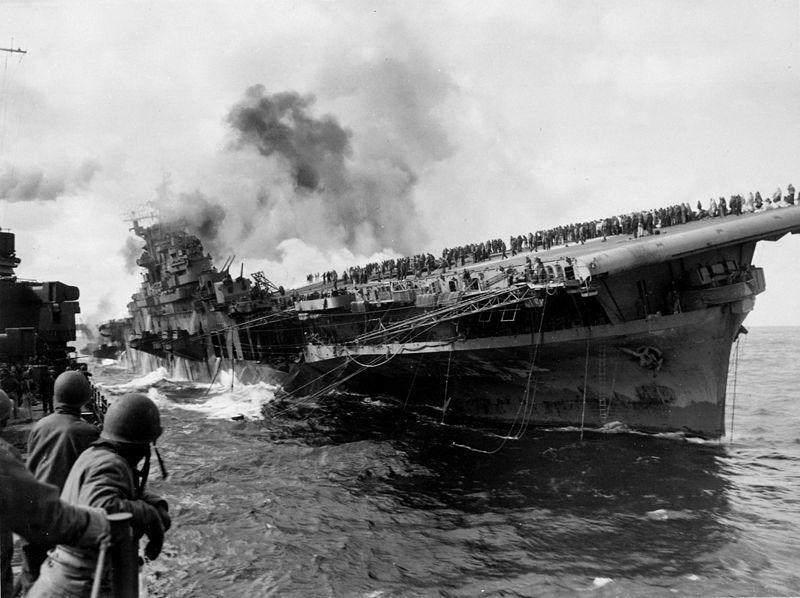
USS Franklin listing 13-degree after a successful Japanese air attack on March 19, 1945. Source: Wikipedia
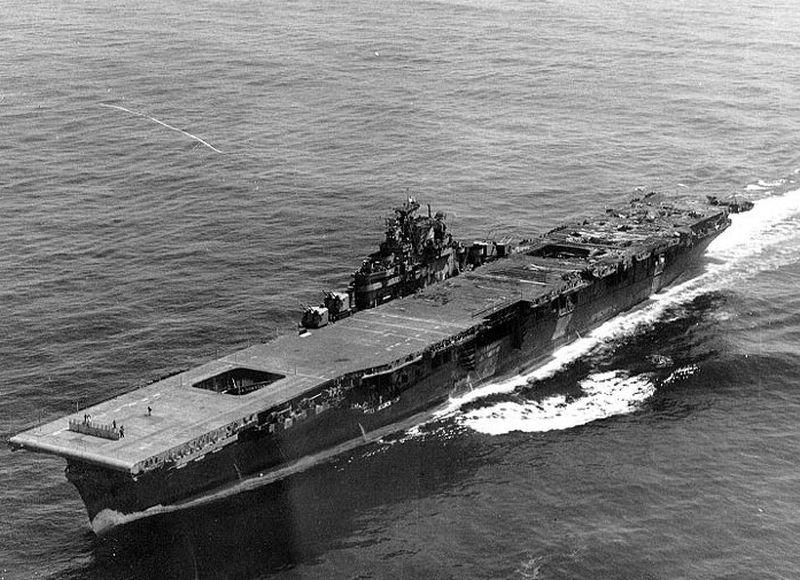
US Franklin arriving in New York, heavily damaged but continuing to sail under its own power, April 1945. Source: Wikipedia
USS Bunker Hill was hit by two kamikazes on the morning of May 11, 1945, during the invasion of Okinawa. An A6M Zero fighter aircraft emerged from the low clouds and dropped a bomb that crashed through the flight deck of the Bunker Hill and then exited through the ship's side into the ocean where it exploded. The Zero itself then crashed onto the flight deck, causing fighter planes parked on deck, which were full of fuel and ammunition, to explode and cause a major fire. The remains of the Zero slid over the flight deck and crashed into the sea. Less than 30 seconds later, a second Zero swooped on the American aircraft carrier. This second kamikaze also dropped a bomb that went through the flight deck and exploded in the hangar below. The explosion caused intense fires and gasoline vapor explosions. The Zero itself then crashed on the flight deck near the bridge island. There were 346 fatalities aboard USS Bunker Hill and 43 crew members were missing. Furthermore, 264 injuries were reported. The damage on board the aircraft carrier was so extensive that the ship had to withdraw from the battle scene. The carrier was able to depart under its own power to Bremerton where the ship was repaired at the Puget Sound Naval Shipyard. Repairs were still underway during VJ-Day (Victory over Japan Day, August 15, 1945).
Even though the Essex-class aircraft carriers proved to be the most decisive American naval units in the second half of World War II, the battleships were still seen, at least symbolically, as the most important ships. The Supreme Commander of the Allied Forces in the Pacific, General Douglas MacArthur, chose the new Iowa-class battleship USS Missouri as the stage for the signing of the Japanese surrender agreement on September 2, 1945, in Tokyo Bay. Furthermore, hundreds of other battleships, cruisers, destroyers, minesweepers, corvettes and the like were present during the ceremony in Tokyo Bay. The aircraft carriers were represented only by the Independence-class carriers USS Bataan and USS Cowpens and three escort aircraft carriers. The Essex carriers were conspicuously absent. However, just after World War II, six more Essex-class aircraft carriers entered service while all the American battleships were retired, except for a few. This also marked the symbolic end of the battleship era.
Definitielijst
- battleship
- Heavily armoured warship with very heavy artillery.
- invasion
- Armed incursion.
- kamikaze
- “Divine Wind”. A kamikaze pilot would fly himself, his airplane and bomb(s) literally into an enemy target, preferably a US ships. This was a noble cause, considered a most honourable death for the emperor. Several thousands of kamikaze pilots died this way.
Essex-class aircraft carriers after the Second World War
Most of the Essex-class aircraft carriers, which had seen action during the Second World War, were decommissioned and placed into conservation in 1947. The eight remaining carriers received the first fighter jets on board and, together with the three new Midway-class aircraft carriers, constituted the backbone of the US Navy from the late 1940s to the early 1950s.
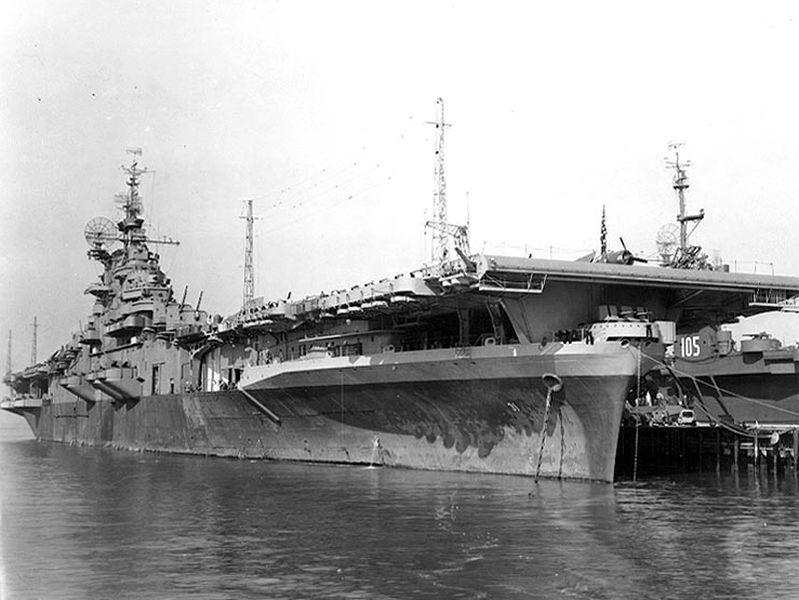
USS Bon Homme Richard at the Naval Shipyard in Alameda, California on October 27, 1945. Source: History Navy
USS Oriskany was delivered according to a new design in 1950. The aircraft carrier had a much more robust flight deck and a newly designed island structure. The original 12.5cm guns and anti-aircraft machine guns had been removed. After all, the latest aircraft carrier tactics stipulated that an aircraft carrier had to protect herself against enemy air attacks by its very own aircraft. Eight of the older Essex-class carriers were converted under the same program, designated SCB-27A, and returned to active service during the Korean War (1950-1953). A further six Essex carriers were upgraded according to the improved SCB-27C modernisation design. These ships were equipped with steam catapults that were much more powerful and reliable than the hydraulic variants. USS Antietam fell outside the SCB-27 program and was provided with an experimental angled deck.
In particular, the use of larger and heavier fighter aircraft required further adaptation of aircraft carriers. That is why many Essex-class aircraft carriers were upgraded again in the second half of the 1950s, but this time according to the SCB-125 program. The major changes of this program involved an angled deck, hull bulges for increased buoyancy, heavier flight deck elevators relocated to edges of the flight decks, heavier bomb elevators, and enclosed “hurricane” bows. The advantage of closing the originally overhanging flight decks on these bows was that the carriers suffered much less storm damage. Some carriers that underwent the SCB-27C modernisation were upgraded according to the SCB-125 program prior to delivery. USS Oriskany was again an exception and underwent a modified SCB-125A program. The most important adjustment was an aluminium flight deck. The carriers converted according to the SCB-27 and SCB-125 plans were classified as Attack Carriers (CVA).
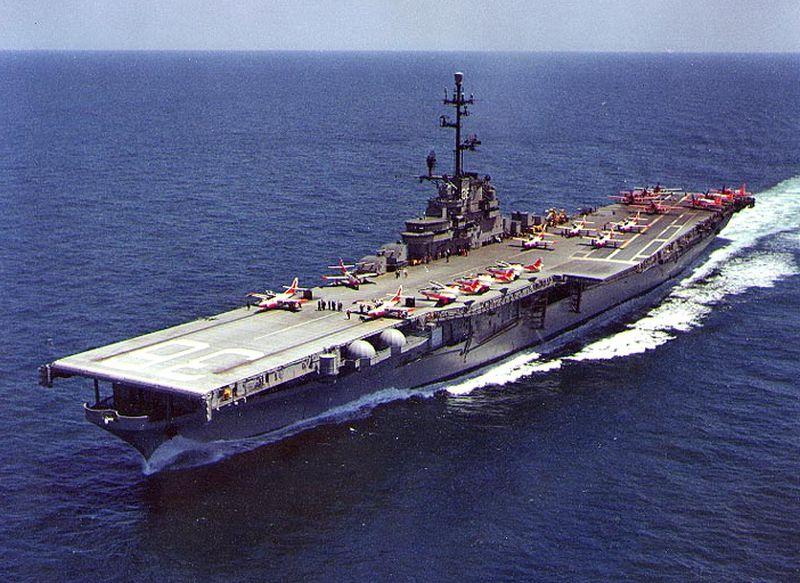
USS Antietam, with an experimental angled deck, as training vessel for navy pilots on April 19, 1961. Source: History Navy
With the arrival of the Forrestal-class supercarriers in the early 1960s, eight Essex-class aircraft carriers were converted into anti-submarine warfare carriers (CVS). Under the SCB-144 program, they were equipped with an SQS-23 bow sonar and aircraft and helicopters to detect and destroy submarines. Three other Essex carriers (USS Boxer, USS Princeton and USS Valley Forge) were excluded from the CVS program and instead re-classified as Landing Platform Helicopters (LPH). The LPH carriers functioned as amphibious assault ships for the Marines and remained in service with their original straight decks until the 1970s. Three ships of the Essex-class (USS Leyte, USS Tarawa and USS Philippine Sea) were never converted and used as attack aircraft carriers (CVA), like some of the other converted Essex carriers.
Ultimately, 22 of the 24 Essex-class aircraft carriers were converted or given a new function after World War II. However, USS Franklin and USS Bunker Hill remained in conservation until they were scrapped in 1966 and 1973. As a result of the extensive damage that the ships in the Pacific had suffered to vital parts such as the hull frames and flight decks, modernisation of both ships was not economical. Due to all the conversion programs, modernisations and reclassifications, no two Essex-class aircraft carriers looked exactly alike anymore, and a well-trained observer could recognise each of the individual ships.
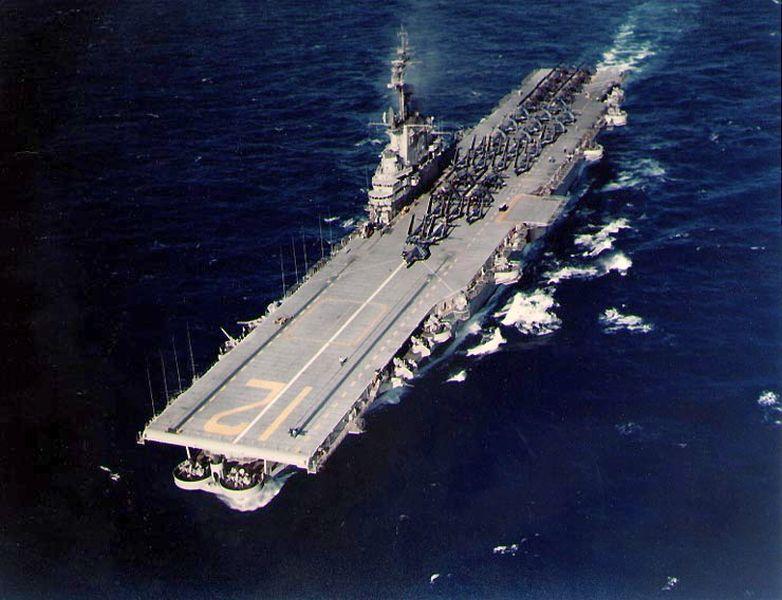
USS Hornet (CV-12) after having completed her SCB-27A conversion on January 10, 1954. Source: Wikipedia
Between 1960 and 1973, several Essex-class carriers gained worldwide fame because they were used as recovery ships in the various American space programs. They recovered both unmanned and manned space capsules after their splashdown in the Pacific Ocean
The arrival of supercarriers during the 1960s and 1970s made the Essex-class aircraft carriers obsolete and redundant. The first carriers of the class were scrapped from the 1970s onwards. However, USS Lexington (CV-16) remained in service as a training ship until 1991. USS Oriskany was removed from the US Naval Vessel Register at the end of the Cold War, after which the carrier was completely stripped. Various parts of the ship can still be seen in various museums. The hull was destined to serve as part of the City of America exhibition in Tokyo Bay, but the Japanese businessmen, who had taken the initiative, ran into financial problems. Subsequently, the hull of the Oriskany was sold for scrapping to Vallejo, California in 1995, but the scrapping contract was voided due to lack of progress. The US Navy took over the remains of the aircraft carrier and donated them to the state of Florida. In 2006, the Oriskany was sunk as an artificial reef in the Gulf of Mexico.
Definitielijst
- Midway
- Island in the Pacific where from 4 to 6 June 1942 a battle was fought between Japan and the United States. The battle of Midway was a turning point in the war in the Pacific resulting in a heavy defeat for the Japanese.
Class overview 2
| Name | Commissioned | Conversion history | Hull nr. | De-commissioned | Fate |
| USS Essex | 31,12,1943, 15-01-1951 | SCB-27A in 1951, SCB-125 in 1956, SCB-144 in 1962 | CV-9, CVA-9, CVS-9 | 09-01-1947, 30-06-1969 | Sold for scrapping 01-06-1975 |
| USS Yorktown | 15-04-1943, 02-01-1953 | SCB-27A in 1953, SCB-125 in 1955, SCB-144 in 1966 | CV-10, CVA-10, CVS-10 | 09-01-1947 | Museum ship in Charleston since 1975 |
| USS Intrepid | 16-08-1943, 09-02-1952, 18-10-1954 | SCB-27C in 1954, SCB-125 in 1955, SCB-144 in 1966 | CV-11, CVA-11, CVS-11 | 22-03-1947, 09-04-1952, 15-03-1974 | Museum ship in New York since 1982 |
| USS Hornet | 29-11-1943, 20-03-1951, 11-09-1953 | SCB-27A in 1953, SCB-125 in 1956, SCB-144 in 1965 | CV-12, CVA-12, CVS-12 | 15-01-1947, 12-05-1951, 26-06-1970 | Museum ship in Alameda since 1998 |
| USS Franklin | 31-01-1944 | - | CV-13 | 17-02-1947 | Sold for scrapping 27-07-1966 |
| USS Ticonderoga | 08-05-1944, 01-10-1954 | SCB-27C in 1954, SCB-125 in 1957 | CV-14, CVA-14, CVS-14 | 09-01-1947, 01-09-1973 | Sold for scrapping 15-08-1974 |
| USS Randolph | 09-10-1944, 01-07-1953 | SCB-27A in 1953, SCB-125 in 1956, SCB-144 in 1961 | CV-15, CVA-15, CVS-15 | 25-02-1948, 13-02-1969 | Sold for scrapping 05-1975 |
| USS Lexington | 17-02-1943, 15-08-1955 | SCB-27C/125 in 1955 | CV-16, CVA-16, CVS-16, CVT-16, AVT-16 | 23-04-1947, 08-11-1991 | Museum ship in Corpus Christi since 1992 |
| USS Bunker Hill | 25-05-1943 | - | CV-17 | 09-01-1947 | Sold for scrapping 05-1973 |
| USS Wasp | 24-10-1943, 28-09-1951 | SCB-27A in 1951, SCB-125 in 1955, SCB-144 in 1964 | CV-18, CVA-18, CVS-18 | 17-02-1947, 01-07-1972 | Sold for scrapping 21-05-1973 |
| USS Hancock | 15-04-1943, 15-02-1954, 15-11-1956 | SCB-27C in 1954, SCB-125 in 1956 | CV-19, CVA-19 | 09-05-1947, 13-04-1956, 30-01-1976 | Sold for scrapping 01-09-1976 |
| USS Bennington | 06-08-1944, 13-11-1952 | SCB-27A in 1952, SCB-125 in 1955, SCB-144 1963 | CV-20, CVA-20, CVS-20 | 08-11-1946, 15-01-1970 | Sold for scrapping 12-01-1994 |
| USS Boxer | 16-04-1945 | Amphibious assault ship | CV-21, CVA-21, CVS-21, LPH-4 | 01-12-1969 | Sold for scrapping 02-1971 |
| USS Bon Homme Richard | 26-11-1944, 15-01-1951, 06-09-1955 | SCB-27C/125 in 1955 | CV-31, CVA-31 | 09-01-1947, 15-05-1953, 02-07-1971 | Sold for scrapping 13-03-1992 |
| USS Leyte | 11-04-1946 | - | CV-32, CVA-32, CVS-32 | 15-05-1959 | Sold for scrapping 09-1970 |
| USS Kearsarge | 02-05-1946 | SCB-27A in 1952, SCB-125 in 1957, SCB-144 in 1962 | CV-33, CVA-33, CVS-33 | 16-06-1950, 13-02-1970 | Sold for scrapping 02-1974 |
| USS Oriskany | 25-09-1950, 07-03-1959 | SCB-27 in 1950, SCB-125A in 1959 | CV-34, CVA-34 | 02-01-1957, 30-09-1976 | Sunk as artificial reef 05-2006 |
| Reprisal | - | - | CV-35 | - | Sold for scrapping 11-49 |
| USS Antietam | 28-01-1945, 17-07-1951 | Experimental angled deck in 1952 | CV-36, CVA-36, CVS-36 | 21-06-1949, 08-05-1963 | Sold for scrapping 28-02-1974 |
| USS Princeton | 18-11-1945, 28-08-1950 | Amphibious assault ship | CV-37, CVA-37, CVS-37, LPH-5 | 21-06-1949, 30-01-1970 | Sold for scrapping 05-1971 |
| USS Shangri-La | 15-09-1944, 10-05-1951 | SCB-27C/125 in 1955 | CV-38, CVA-38, CVS-38 | 07-11-1947, 30-07-1971 | Sold for scrapping 09-08-1988 |
| USS Lake Champlain | 03-06-1945, 19-09-1952 | SCB-27A in 1952 | CV-39, CVA-39, CVS-39 | 17-02-1947, 02-05-1966 | Sold for scrapping 28-04-1972 |
| USS Tarawa | 08-12-1945, 03-02-1951 | - | CV-40, CVA-40, CVS-40 | 30-06-1949, 13-05-1960 | Sold for scrapping 03-10-1968 |
| USS Valley Forge | 03-11-1946 | Amphibious assault ship | CV-45, CVA-45, CVS-45, LHP-8 | 16-01-1970 | Sold for scrapping10-1971 |
| Iwo Jima | - | - | CV-46 | - | Hull scrapped in 1946 |
| USS Philippine Sea | 11-05-1946 | - | CV-47, CVA-47, CVS-47 | 28-12-1958 | Sold for scrapping 23-03-1971 |
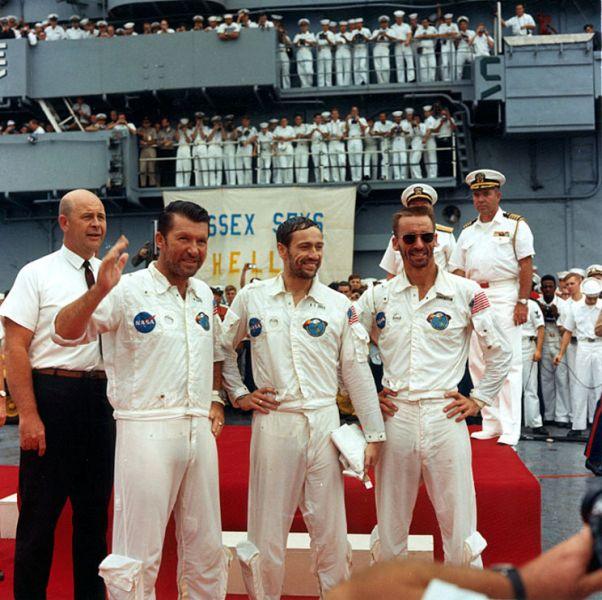
Astronauts aboard USS Essex after the recovery of Apollo 7 on October 22, 1968. Source: Courtesy of Michael W. Pocock
Epilogue
The Essex-class aircraft carriers were the most important capital ships after World War 2; not just in the US Navy, but in the entire world. Aircraft carriers, as a class, had taken over the role of battleships as the backbone of a war fleet. After the war, the development of battleships ceased, while the evolution of the aircraft carrier only really got underway after 1945. This was mainly the result of the adjustments required for large aircraft carriers to operate increasingly larger and heavier jet aircraft.
During the Cold War, only the Soviet Navy was able to (marginally) keep up with the development of aircraft carriers. However, the Americans maintained the lead by far, which they had built up during the Second World War with the Essex class. The Essex class was succeeded by the larger Midway class, which consisted of three ships only. Since the Essex class and the Midway class, the US Navy developed the so-called supercarriers, which had an increasingly large displacement; from the 60,000 tons Forrestal class to the 100,000 tons Nimitz class. At present, the US Navy is the only naval force in the world with supercarriers in service.
Four of the evocative Essex-class aircraft carriers have been preserved. These are USS Yorktown (CV-10), which is the flagship of the Patriots Point Naval and Maritime Museum in Charleston, South Carolina since 1975. In 1982, USS Intrepid was opened as a museum ship and has since become one of New York City's top tourist attractions. Since 1992, USS Lexington (CV-16) can be visited as a museum ship in Corpus Christi, Southeast Texas. USS Hornet (CV-12) was decommissioned on June 26, 1970, and inducted into the Pacific Reserve Fleet at the Puget Sound Naval Shipyard. On July 25, 1989, the carrier was removed from the US Navy's Naval Vessel Register but declared a National Historic Landmark two years later. This status saved the aircraft carrier from scrapping and on May 26, 1998, the carrier was donated to the Aircraft Carrier Hornet Foundation. On October 17 of the same year, she was opened to the public as a museum ship and given a permanent berth in Alameda, California. The following year, USS Hornet was declared a California State Historic Landmark and placed on the National Register of Historic Places. This means that the future of the historic aircraft carrier is guaranteed by the state of California.
Definitielijst
- Midway
- Island in the Pacific where from 4 to 6 June 1942 a battle was fought between Japan and the United States. The battle of Midway was a turning point in the war in the Pacific resulting in a heavy defeat for the Japanese.
Information
- Article by:
- Peter Kimenai
- Translated by:
- Simon van der Meulen
- Published on:
- 18-01-2025
- Feedback?
- Send it!
Related sights
Related books
Sources
- IRELAND, B., Vliegdekschepen, Veltman Uitgevers, Utrecht, 2007.
- LYON, H, Encyclopedie van de belangrijkste oorlogsschepen ter wereld, Scriptoria, Antwerpen, 1980.
- MACINTYRE, D., Vliegkampschepen, Standaard Uitgeverij Antwerpen, Antwerpen, 1989.
- MCCURTIE, F.E., Jane's fighting ships of world war II, Studio, Londen, 2001.
